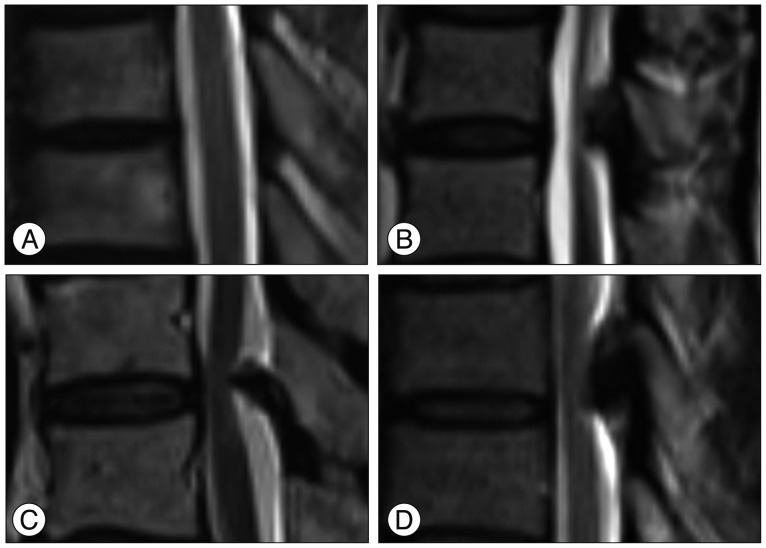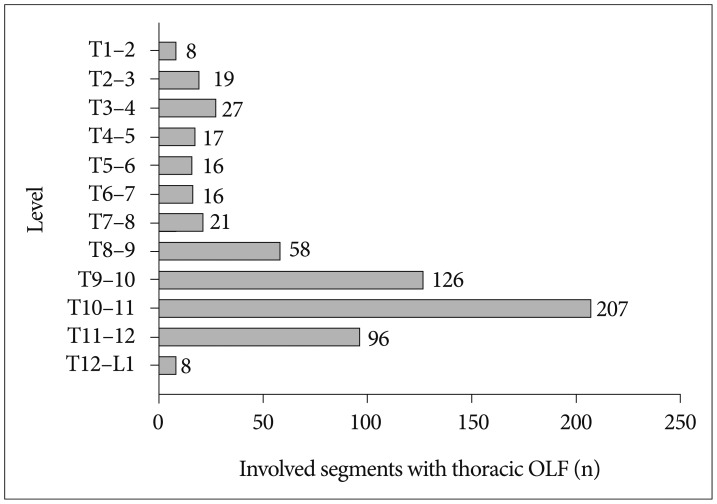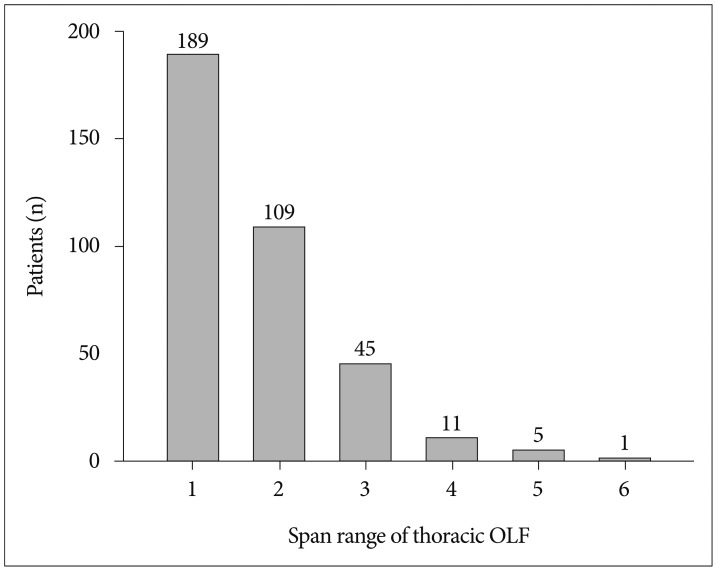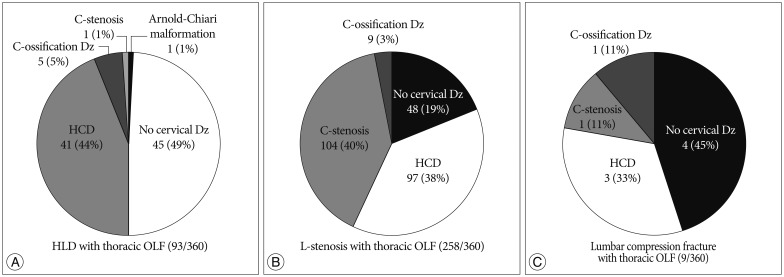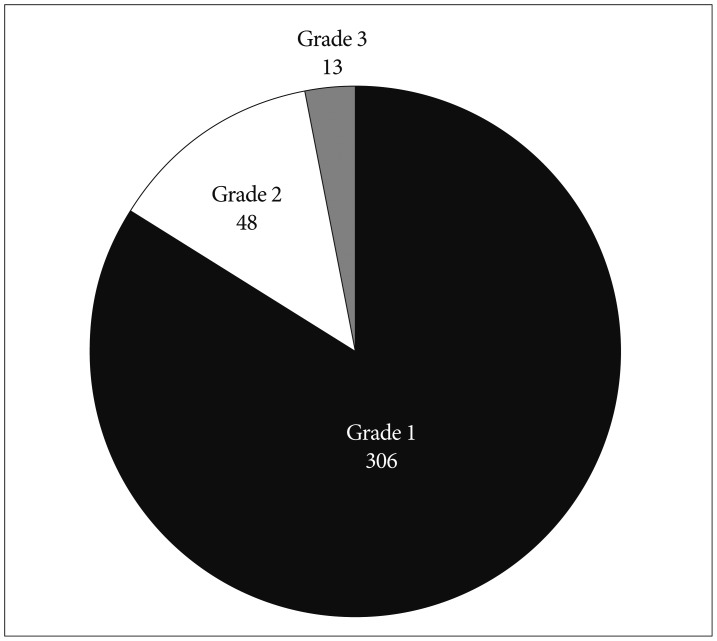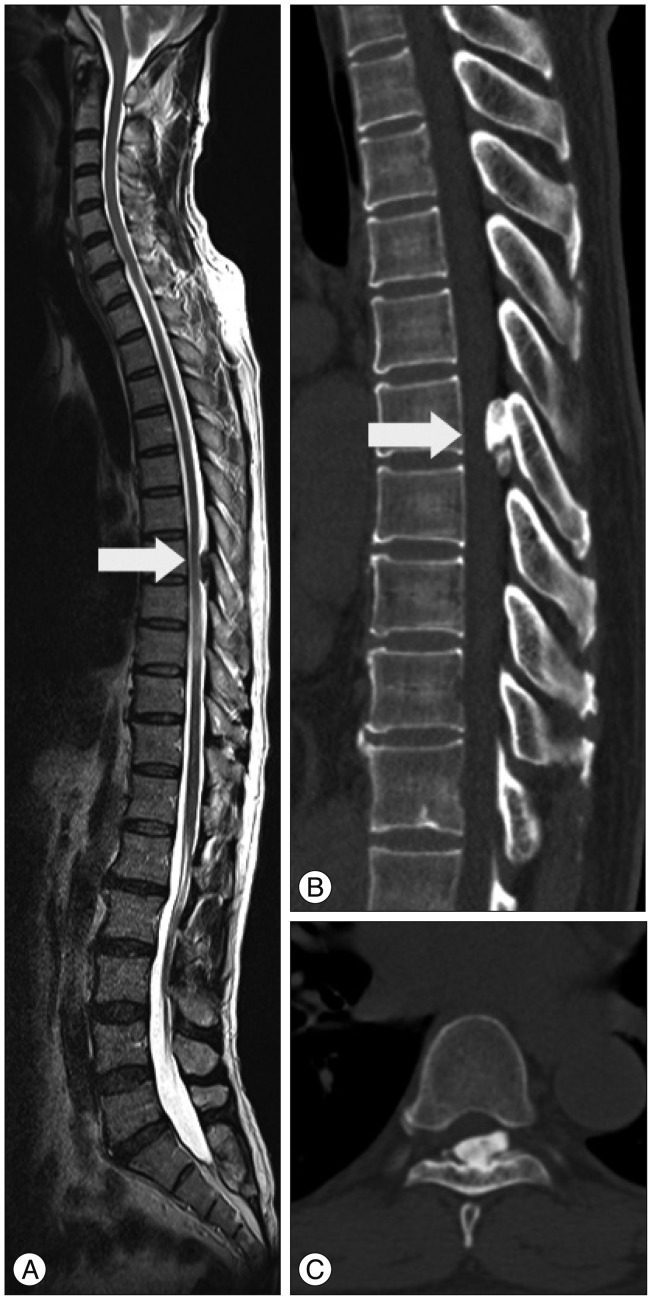J Korean Neurosurg Soc.
2015 Aug;58(2):112-118. 10.3340/jkns.2015.58.2.112.
Prevalence, Distribution, and Significance of Incidental Thoracic Ossification of the Ligamentum Flavum in Korean Patients with Back or Leg Pain : MR-Based Cross Sectional Study
- Affiliations
-
- 1Department of Neurosurgery, Chonnam National University Hospital and Medical School, Gwangju, Korea.
- 2Department of Neurosurgery, Gangnam Severance Hospital, The Spinal and Spinal Cord Institute, Yonsei University College of Medicine, Seoul, Korea. dkchin@yuhs.ac
- 3Department of Radiology, Gangnam Severance Hospital, Yonsei University College of Medicine, Seoul, Korea.
- KMID: 2191318
- DOI: http://doi.org/10.3340/jkns.2015.58.2.112
Abstract
OBJECTIVE
Thoracic ossification of the ligamentum flavum (OLF) is a relatively rare disease. Because of ambiguous clinical symptom, it is difficult for early diagnosis of OLF and subsequent treatment can be delayed or missed. Therefore, the purpose of this study is to comprehensively assess the prevalence and distribution of thoracic OLF by magnetic resonance imaging (MRI) and coexisting spinal disease in Korean patients with back pain or leg pain.
METHODS
The sample included 2134 Korean patients who underwent MRI evaluation for back pain. The prevalence and distribution of thoracic OLF were assessed using lumbar MRI with whole spine sagittal images. Additionally, we examined the presence of coexisting lumbar and cervical diseases. The presence of thoracic OLF as well as clinical parameters such as age, sex, and surgery were retrospectively reviewed.
RESULTS
The prevalence of thoracic OLF in total patients was 16.9% (360/2134). The prevalence tended to increase with aging and was higher in women than in men. The lower thoracic segment of T10-11 was the most frequently affected segment. Of the 360 patients with OLF, 31.9% had coexisting herniated thoracic discs at the same level. Approximately 74% of the patients with OLF had coexisting lumbar and cervical disease. Nine (2.5%) of 360 OLF patients underwent surgery for thoracic lesion.
CONCLUSION
The prevalenceof thoracic OLF was relatively higher than those of previous reports. And coexisting lumbar and cervical disease were very frequent. Therefore, we should check coexisting spinal diseases and the exact diagnostic localization of ossification besides lumbar disease.
Keyword
MeSH Terms
Figure
Reference
-
1. Aizawa T, Sato T, Sasaki H, Kusakabe T, Morozumi N, Kokubun S. Thoracic myelopathy caused by ossification of the ligamentum flavum : clinical features and surgical results in the Japanese population. J Neurosurg Spine. 2006; 5:514–519. PMID: 17176015.
Article2. Aizawa T, Sato T, Tanaka Y, Ozawa H, Hoshikawa T, Ishii Y, et al. Thoracic myelopathy in Japan : epidemiological retrospective study in Miyagi Prefecture during 15 years. Tohoku J Exp Med. 2006; 210:199–208.
Article3. al-Orainy IA, Kolawole T. Ossification of the ligament flavum. Eur J Radiol. 1998; 29:76–82. PMID: 9934562.
Article4. Baur ST, Mai JJ, Dymecki SM. Combinatorial signaling through BMP receptor IB and GDF5 : shaping of the distal mouse limb and the genetics of distal limb diversity. Development. 2000; 127:605–619. PMID: 10631181.
Article5. Fukuyama S, Nakamura T, Ikeda T, Takagi K. The effect of mechanical stress on hypertrophy of the lumbar ligamentum flavum. J Spinal Disord. 1995; 8:126–130. PMID: 7606119.
Article6. Furusawa N, Baba H, Maezawa Y, Uchida K, Wada M, Imura S, et al. Calcium crystal deposition in the ligamentum flavum of the lumbar spine. Clin Exp Rheumatol. 1997; 15:641–647. PMID: 9444420.7. Guo JJ, Luk KD, Karppinen J, Yang H, Cheung KM. Prevalence, distribution, and morphology of ossification of the ligamentum flavum : a population study of one thousand seven hundred thirty-six magnetic resonance imaging scans. Spine (Phila Pa 1976). 2010; 35:51–56. PMID: 20042956.
Article8. Guo JJ, Yang HL, Cheung KM, Tang TS, Luk KD. Classification and management of the tandem ossification of the posterior longitudinal ligament and flaval ligament. Chin Med J (Engl). 2009; 122:219–224. PMID: 19187650.9. Han IH, Suh SH, Kuh SU, Chin DK, Kim KS. Types and prevalence of coexisting spine lesions on whole spine sagittal MR images in surgical degenerative spinal diseases. Yonsei Med J. 2010; 51:414–420. PMID: 20376895.
Article10. Hayashi K, Ishidou Y, Yonemori K, Nagamine T, Origuchi N, Maeda S, et al. Expression and localization of bone morphogenetic proteins (BMPs) and BMP receptors in ossification of the ligamentum flavum. Bone. 1997; 21:23–30. PMID: 9213004.
Article11. He S, Hussain N, Li S, Hou T. Clinical and prognostic analysis of ossified ligamentum flavum in a Chinese population. J Neurosurg Spine. 2005; 3:348–354. PMID: 16302628.
Article12. Inaba K, Matsunaga S, Ishidou Y, Imamura T, Yoshida H. Effect of transforming growth factor-beta on fibroblasts in ossification of the posterior longitudinal ligament. In Vivo. 1996; 10:445–449. PMID: 8839792.13. Kang KC, Lee CS, Shin SK, Park SJ, Chung CH, Chung SS. Ossification of the ligamentum flavum of the thoracic spine in the Korean population. J Neurosurg Spine. 2011; 14:513–519. PMID: 21275554.
Article14. Kawaguchi H, Kurokawa T, Hoshino Y, Kawahara H, Ogata E, Matsumoto T. Immunohistochemical demonstration of bone morphogenetic protein-2 and transforming growth factor-beta in the ossification of the posterior longitudinal ligament of the cervical spine. Spine (Phila Pa 1976). 1992; 17(3 Suppl):S33–S36. PMID: 1566182.15. Kuh SU, Kim YS, Cho YE, Jin BH, Kim KS, Yoon YS, et al. Contributing factors affecting the prognosis surgical outcome for thoracic OLF. Eur Spine J. 2006; 15:485–491. PMID: 15902507.
Article16. Kurihara A, Tanaka Y, Tsumura N, Iwasaki Y. Hyperostotic lumbar spinal stenosis. A review of 12 surgically treated cases with roentgenographic survey of ossification of the yellow ligament at the lumbar spine. Spine (Phila Pa 1976). 1988; 13:1308–1316. PMID: 3144759.17. Lang N, Yuan HS, Wang HL, Liao J, Li M, Guo FX, et al. Epidemiological survey of ossification of the ligamentum flavum in thoracic spine : CT imaging observation of 993 cases. Eur Spine J. 2013; 22:857–862. PMID: 22983651.
Article18. Liao CC, Chen TY, Jung SM, Chen LR. Surgical experience with symptomatic thoracic ossification of the ligamentum flavum. J Neurosurg Spine. 2005; 2:34–39. PMID: 15658124.
Article19. Miyasaka K, Kaneda K, Ito T, Takei H, Sugimoto S, Tsuru M. Ossification of spinal ligaments causing thoracic radiculomyelopathy. Radiology. 1982; 143:463–468. PMID: 7071348.
Article20. Miyasaka K, Kaneda K, Sato S, Iwasaki Y, Abe S, Takei H, et al. Myelopathy due to ossification or calcification of the ligamentum flavum : radiologic and histologic evaluations. AJNR Am J Neuroradiol. 1983; 4:629–632. PMID: 6410817.21. Mori K, Kasahara T, Mimura T, Nishizawa K, Murakami Y, Matsusue Y, et al. Prevalence, distribution, and morphology of thoracic ossification of the yellow ligament in Japanese : results of CT-based cross-sectional study. Spine (Phila Pa 1976). 2013; 38:E1216–E1222. PMID: 24509558.22. Nishiura I, Isozumi T, Nishihara K, Handa H, Koyama T. Surgical approach to ossification of the thoracic yellow ligament. Surg Neurol. 1999; 51:368–372. PMID: 10199288.
Article23. Ono M, Russell WJ, Kudo S, Kuroiwa Y, Takamori M, Motomura S, et al. Ossification of the thoracic posterior longitudinal ligament in a fixed population. Radiological and neurological manifestations. Radiology. 1982; 143:469–474. PMID: 7071349.
Article24. Pantazis G, Tsitsopoulos P, Bibis A, Mihas C, Chatzistamou I, Kouzelis C. Symptomatic ossification of the ligamentum flavum at the lumbar spine : a retrospective study. Spine (Phila Pa 1976). 2008; 33:306–311. PMID: 18303464.25. Park JY, Chin DK, Kim KS, Cho YE. Thoracic ligament ossification in patients with cervical ossification of the posterior longitudinal ligaments : tandem ossification in the cervical and thoracic spine. Spine (Phila Pa 1976). 2008; 33:E407–E410. PMID: 18520926.26. Polgar F. Uber interakuelle wirbelverkalkung. Fortschr Geb Rontgenstrahlen Erganzungsbd. 1920; 40:292–298.27. Postacchini F, Gumina S, Cinotti G, Perugia D, DeMartino C. Ligamenta flava in lumbar disc herniation and spinal stenosis. Light and electron microscopic morphology. Spine (Phila Pa 1976). 1994; 19:917–922. PMID: 8009349.28. Resnick D, Guerra J Jr, Robinson CA, Vint VC. Association of diffuse idiopathic skeletal hyperostosis (DISH) and calcification and ossification of the posterior longitudinal ligament. AJR Am J Roentgenol. 1978; 131:1049–1053. PMID: 104572.
Article29. Saiki K, Hattori A, Kawai S, Miyamoto T, Tsue K, Kotani H. The ossification of the yellow ligament in the thoracic spine : incidence, classification, neurological finding and narrow spinal canal. Orthop Surg Traumatol (Jpn). 1981; 24:191–199.30. Shiokawa K, Hanakita J, Suwa H, Saiki M, Oda M, Kajiwara M. Clinical analysis and prognostic study of ossified ligamentum flavum of the thoracic spine. J Neurosurg. 2001; 94(2 Suppl):221–226. PMID: 11302624.
Article31. Sugimura H, Kakitsubata Y, Suzuki Y, Kakitsubata S, Tamura S, Uwada O, et al. MRI of ossification of ligamentum flavum. J Comput Assist Tomogr. 1992; 16:73–76. PMID: 1729311.
Article32. Takeuchi A, Miyamoto K, Hosoe H, Shimizu K. Thoracic paraplegia due to missed thoracic compressive lesions after lumbar spinal decompression surgery. Report of three cases. J Neurosurg. 2004; 100(1 Suppl Spine):71–74. PMID: 14748578.
Article33. Ugarriza LF, Cabezudo JM, Porras LF, Rodríguez-Sánchez JA. Cord compression secondary to cervical disc herniation associated with calcification of the ligamentum flavum : case report. Neurosurgery. 2001; 48:673–676. PMID: 11270560.
Article34. Xiong L, Zeng QY, Jinkins JR. CT and MRI characteristics of ossification of the ligamenta flava in the thoracic spine. Eur Radiol. 2001; 11:1798–1802. PMID: 11511904.
Article
- Full Text Links
- Actions
-
Cited
- CITED
-
- Close
- Share
- Similar articles
-
- Thoracic Myelopathy Due to Ossification of Ligamentum Flavum: Three cases Report
- Three Cases of Thoracic Myelopathy due to Ligamentum Flavum Ossification
- Three Cases of Ossification of Ligamentum Flavum Causing Thoracic Myelopathy
- As a Cause of Myelopathy in the Lower Thracic Spines ): Two Cases Report
- Thoracic Myelopathy Caused by Ossified Ligamentum Flavum: Case Report

